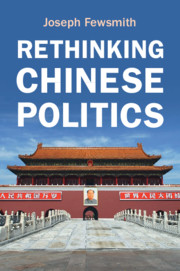Book contents
- Rethinking Chinese Politics
- Rethinking Chinese Politics
- Copyright page
- Dedication
- Contents
- Tables
- Figures
- Acknowledgments
- Abbreviations
- Introduction
- 1 The Dengist Structure of Power
- 2 Succession and the Art of Consolidating Power
- 3 Hu Jintao and the Limits of Institutionalization
- 4 The Pathologies of Reform Leninism
- 5 Xi Jinping’s Centralization of Power
- 6 The Nineteenth Party Congress and Reinvigorating Leninism
- Conclusion
- Bibliography
- Index
5 - Xi Jinping’s Centralization of Power
Published online by Cambridge University Press: 10 June 2021
- Rethinking Chinese Politics
- Rethinking Chinese Politics
- Copyright page
- Dedication
- Contents
- Tables
- Figures
- Acknowledgments
- Abbreviations
- Introduction
- 1 The Dengist Structure of Power
- 2 Succession and the Art of Consolidating Power
- 3 Hu Jintao and the Limits of Institutionalization
- 4 The Pathologies of Reform Leninism
- 5 Xi Jinping’s Centralization of Power
- 6 The Nineteenth Party Congress and Reinvigorating Leninism
- Conclusion
- Bibliography
- Index
Summary
The rise of Xi Jinping presents a stark contrast to the early periods of Jiang Zemin’s and Hu Jintao’s rule. Like Jiang and Hu, Xi was given a weak hand to play. But unlike Jiang and Hu, Xi launched a campaign against corruption that strengthened his power enormously. At the same time, he stressed the threat of “peaceful evolution,” which had brought down the Soviet Union, and underlay the “color revolutions” in Central Asia. This campaign saw a tightening of control over ideology. Xi also undertook an extensive reform of the military. Although this reform facilitated operational matters, it enabled Xi to gain personal control over the military (PLA).
Keywords
- Type
- Chapter
- Information
- Rethinking Chinese Politics , pp. 131 - 156Publisher: Cambridge University PressPrint publication year: 2021
- 1
- Cited by

